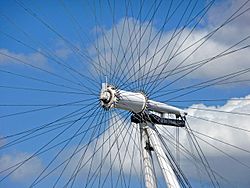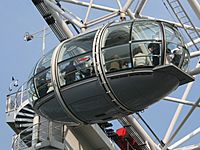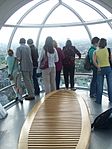London Eye facts for kids
Quick facts for kids London Eye |
|
|---|---|
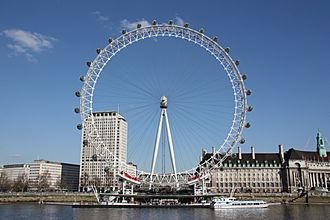 |
|
| Alternative names | Millennium Wheel |
| General information | |
| Status | Operating |
| Type | Observation wheel |
| Location | Lambeth, London |
| Address | Riverside Building, County Hall, Westminster Bridge Road |
| Coordinates | 51°30′12″N 0°07′10″W / 51.5033°N 0.1194°W |
| Completed | March 2000 |
| Opened |
|
| Cost | £70 million |
| Owner | Merlin Entertainments |
| Height | 135 metres (443 ft) |
| Dimensions | |
| Diameter | 120 metres (394 ft) |
| Design and construction | |
| Architect |
|
| Architecture firm | Marks Barfield |
| Structural engineer | Arup |
| Other designers |
|
| Awards and prizes | Institution of Structural Engineers Special Award 2001 |
The London Eye is a large metal Ferris wheel. It is also known as the Millennium Wheel and is one of the largest observation wheels in the world. It is the most popular paid tourist attraction in the United Kingdom with over three million visitors annually. It has made many appearances in popular culture.
The structure is 135 metres (443 ft) tall and the wheel has a diameter of 120 metres (394 ft). When it opened to the public in 2000 it was the world's tallest Ferris wheel. Its height was surpassed by the 140 metres (459 ft) Sun of Moscow in 2022, the 160 metres (525 ft) Star of Nanchang in 2006, the 165 metres (541 ft) Singapore Flyer in 2008, the 167 metres (548 ft) High Roller (Las Vegas) in 2014, and the 250 metres (820 ft) Ain Dubai in 2021. Supported by an A-frame on one side only, unlike these taller examples, the Eye is described by its operators as "the world's tallest cantilevered observation wheel". The Eye offered the highest public viewing point in London until it was superseded by the 245-metre-high (804 ft) observation deck on the 72nd floor of The Shard in early 2013.
The London Eye adjoins the western end of Jubilee Gardens (previously the site of the former Dome of Discovery), on the South Bank of the River Thames between Westminster Bridge and Hungerford Bridge beside County Hall, in the London Borough of Lambeth. The nearest tube station is Waterloo.
Contents
Design and construction
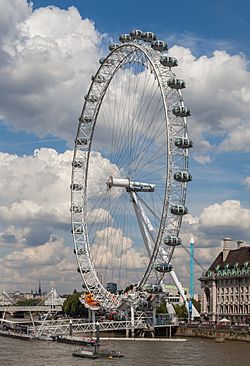
The London Eye was designed by the husband-and-wife team of Julia Barfield and David Marks of Marks Barfield Architects.
The rim of the Eye is supported by tensioned steel cables and resembles a huge spoked bicycle wheel. The lighting was re-done with LED lighting from Color Kinetics in December 2006 to allow digital control of the lights as opposed to the manual replacement of gels over fluorescent tubes.
The wheel was constructed in sections which were floated up the Thames on barges and assembled lying flat on piled platforms in the river. Once the wheel was complete it was lifted into an upright position by a strand jack system made by Enerpac. It was first raised at 2 degrees per hour until it reached 65 degrees, then left in that position for a week while engineers prepared for the second phase of the lift. The project was European with major components coming from six countries: the steel was supplied from the UK and fabricated in The Netherlands by the Dutch company Hollandia, the cables came from Italy, the bearings came from Germany, the spindle and hub were cast in the Czech Republic, the capsules were made by Poma in France (and the glass for these came from Italy), and the electrical components from the UK.
Opening
The London Eye was formally opened by the Prime Minister Tony Blair on 31 December 1999, but did not open to the paying public until 9 March 2000 because of a capsule clutch problem.
The London Eye was originally intended as a temporary attraction, with a five-year lease. In December 2001, operators submitted an application to Lambeth Council to give the London Eye permanent status, and the application was granted in July 2002.
On 5 June 2008 it was announced that 30 million people had ridden the London Eye since it opened.
Passenger capsules
The wheel's 32 sealed and air-conditioned ovoidal passenger capsules, designed and supplied by Poma, are attached to the external circumference of the wheel and rotated by electric motors. The capsules are numbered from 1 to 33, excluding number 13 for superstitious reasons. Each of the 10-tonne (11-short-ton) capsules represents one of the London Boroughs, and holds up to 25 people, who are free to walk around inside the capsule, though seating is provided. The wheel rotates at 26 cm (10 in) per second (about 0.9 km/h or 0.6 mph) so that one revolution takes about 30 minutes, giving a theoretical capacity of 1,600 passengers per hour. It does not usually stop to take on passengers; the rotation rate is slow enough to allow passengers to walk on and off the moving capsules at ground level. It is stopped to allow disabled or elderly passengers time to embark and disembark safely.
In 2009 the first stage of a £12.5 million capsule upgrade began. Each capsule was taken down and floated down the river to Tilbury Docks in Essex.
On 2 June 2013 a passenger capsule was named the Coronation Capsule to mark the 60th anniversary of the coronation of Queen Elizabeth II.
In March 2020, the London Eye celebrated its 20th birthday by turning several of its pods into experiences themed around London. The experiences included a pub in a capsule, a west end theatre pod and a garden party with flower arrangements to represent the eight London Royal parks.
Transport links
The nearest London Underground station is Waterloo, although Charing Cross, Embankment, and Westminster are also within easy walking distance.
Connection with National Rail services is made at London Waterloo station and London Waterloo East station.
London River Services operated by Thames Clippers and City Cruises stop at the London Eye Pier.
Images for kids
-
The Eye on the South Bank of the Thames, with Jubilee Gardens (left) and County Hall (right) in the background
-
Colourful London Eye near County Hall
See also
 In Spanish: London Eye para niños
In Spanish: London Eye para niños


